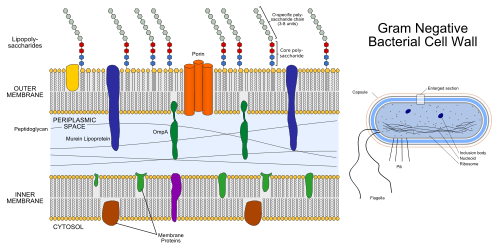Gram-negative bacterial infection
| Gram-negative bacterial infection | |
|---|---|
 | |
| Gram negative cell wall | |
| Classification and external resources | |
| MeSH | D016905 |
Gram-negative bacterial infection refers to a disease caused by gram-negative bacteria. One example is E. coli.[1]
It is important to recognize that this class is defined morphologically (by the presence of a bacterial outer membrane), and not histologically (by a pink appearance when stained), though the two usually coincide.
One reason for this division is that the outer membrane is of major clinical significance: it can play a role in the reduced effectiveness of certain antibiotics,[2] and it is the source of endotoxin.[3]
The gram status of some organisms is complex or disputed:
- Mycoplasma are sometimes considered gram negative,[4][5] but because of its lack of a cell wall and unusual membrane composition, it is sometimes considered separately from other gram-negative bacteria.[6]
- Gardnerella is often considered gram negative,[7] but it is classified in MeSH as both gram positive and gram negative.[8] It has some traits of gram positive bacteria,[9] but has a gram negative appearance.[10] It has been described as a "gram-variable rod".[11][12]
References
- ↑ Cordonnier C, Herbrecht R, Buzyn A, et al. (August 2005). "Risk factors for Gram-negative bacterial infections in febrile neutropenia". Haematologica. 90 (8): 1102–9. PMID 16079110.
- ↑ Pagès JM, Masi M, Barbe J (August 2005). "Inhibitors of efflux pumps in Gram-negative bacteria". Trends Mol Med. 11 (8): 382–9. doi:10.1016/j.molmed.2005.06.006. PMID 15996519.
- ↑ "Introduction: Bacterial Infections: Merck Manual Home Edition".
- ↑ Mycoplasma at the US National Library of Medicine Medical Subject Headings (MeSH)
- ↑ "mycoplasma" at Dorland's Medical Dictionary
- ↑ Sasaki T (April 1991). "Evidence that mycoplasmas, gram-negative bacteria, and certain gram-positive bacteria share a similar protein antigen". J. Bacteriol. 173 (7): 2398–400. PMC 207793
 . PMID 2007558.
. PMID 2007558. - ↑ "Gardnerella" at Dorland's Medical Dictionary
- ↑ Gardnerella at the US National Library of Medicine Medical Subject Headings (MeSH)
- ↑ Sadhu K, Domingue PA, Chow AW, Nelligan J, Cheng N, Costerton JW (July 1989). "Gardnerella vaginalis has a gram-positive cell-wall ultrastructure and lacks classical cell-wall lipopolysaccharide". J. Med. Microbiol. 29 (3): 229–35. doi:10.1099/00222615-29-3-229. PMID 2787405.
- ↑ Cook RL, Reid G, Pond DG, Schmitt CA, Sobel JD (September 1989). "Clue cells in bacterial vaginosis: immunofluorescent identification of the adherent gram-negative bacteria as Gardnerella vaginalis". J. Infect. Dis. 160 (3): 490–6. doi:10.1093/infdis/160.3.490. PMID 2668431.
- ↑ "eMedicine - Gardnerella : Article by Diana Curran". Retrieved 2008-12-07.
- ↑ "eMedicine/Stedman Medical Dictionary Lookup!".
This article is issued from Wikipedia - version of the 5/26/2016. The text is available under the Creative Commons Attribution/Share Alike but additional terms may apply for the media files.